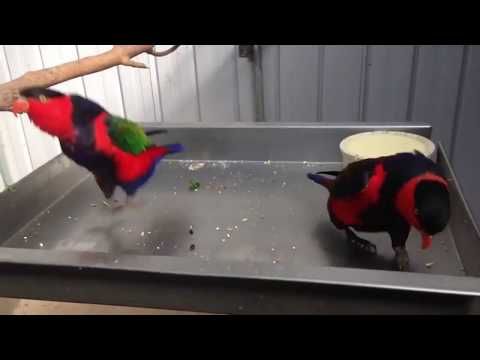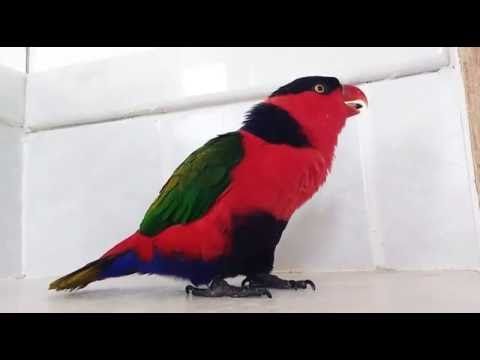Thinking about adding a black-capped lory (Lorius lory) to your family? Good choice! These colorful New Guinean natives can make fantastic pets. They do need some special care, however, and due to their unusual diet, they aren’t recommended for beginning parrot keepers. Do you have what it takes?
Keep reading for everything you need to know about caring for a black-capped lory!
| Name(s) (common, scientific) | Black-capped lory, tricolored lory, black-capped lorikeet, Lorius lory |
| Natural habitat | New Guinea |
| Adult size | 30cm (12″), 200 grams (7 oz.) |
| Lifespan | 20+ years |
| Noise level | Medium |
This post contains affiliate links. If you make a purchase, a small percentage will go directly to Psittacology at no additional cost to you. Thank you for supporting Psittacology!
Black-capped lory appearance
It’s difficult to overlook the colorful black-capped lory! This stout parrot grows to a maximum size of around 30cm (12″) in length and sports the short, stubby tail typical for lories. An adult bird will weigh around 200 grams (7 oz.).
There are seven subspecies of Lorius lory in total, all of which look slightly different in terms of colors and patterns. What they all have in common is their red base coloration, bright orange beak, black hat, blue “pants”, green wings, and yellow tail underside. Quite an array of colors!
Young black-capped lories can be recognized from the fact that their bellies feature less blue coloration. The difference between males and females can only be told by means of a DNA test (or if one lays an egg, that helps as well).
These are the currently recognized subspecies:
- Lorius lory lory
- Lorius lory erythrothorax
- Lorius lory somu
- Lorius lory salvadorii
- Lorius lory viridicrissalis
- Lorius lory jobiensis
- Lorius lory cyanuchen
It’s very easy to confuse the black-capped lory with its close cousin, the purple-bellied lory (Lorius hypoinochrous), but it is possible to tell the two apart from up close.
Purple-bellies lack the black neck patch that most subspecies of black-cap have, and, most strikingly, they have a bright white cere (nose area). The cere in black-capped lories is greyish.
Tip: The black lory (Chalcopsitta atra) might have a similar name, but don’t confuse the two. They’re completely different birds!
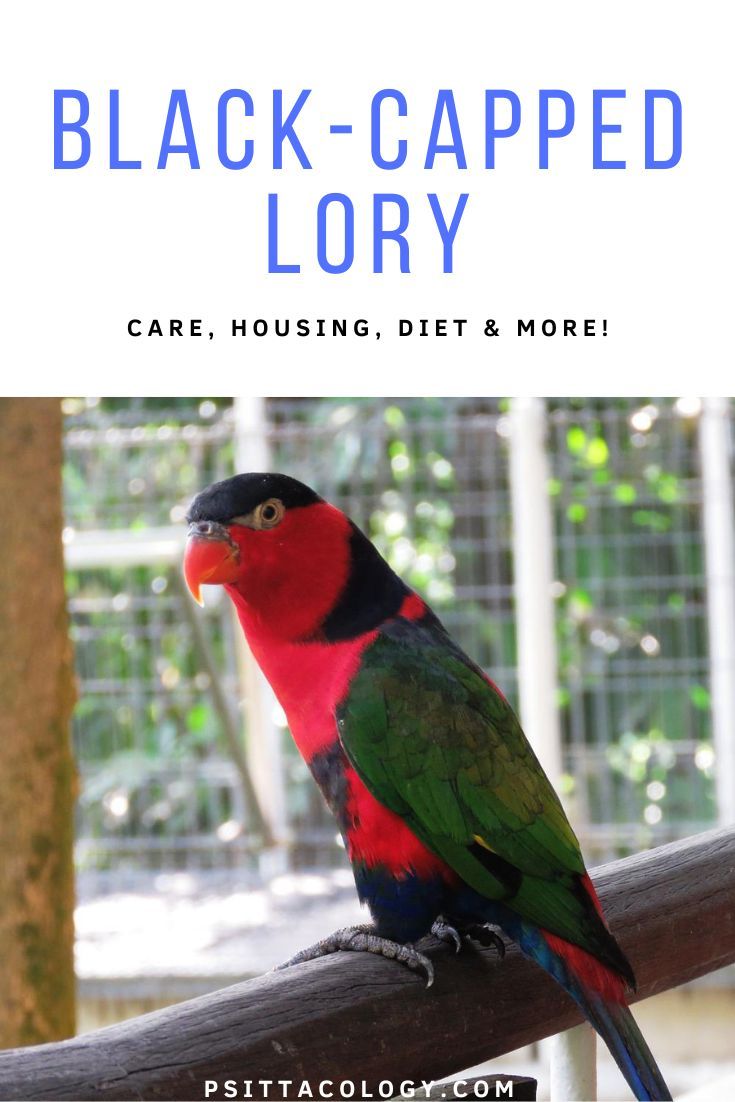
Black-capped lory natural habitat
The black-capped lory is an Asian native that’s naturally found in New Guinea, as well as a few surrounding islands like Japen and Mios Num. Here, the species inhabits forests, forest edges and wetlands, normally at altitudes of up to 1,000m (3280ft) maximum.
The species is relatively shy in the wild, so information about their habits, especially breeding, is not complete yet. It’s known they usually travel in pairs or small groups rather than big flocks.
The IUCN Red List considers Lorius lory to be a species of Least Concern, meaning it’s not threatened.
Did you know? The first description of the black-capped lory in the West was by George Edwards in 1751 in “A Natural History of Uncommon Birds”. You can read his description online for free, since it is now in the public domain! He also included the not-so-charming illustration below.
A natural history of uncommon birds: and of some other rare and undescribed animals
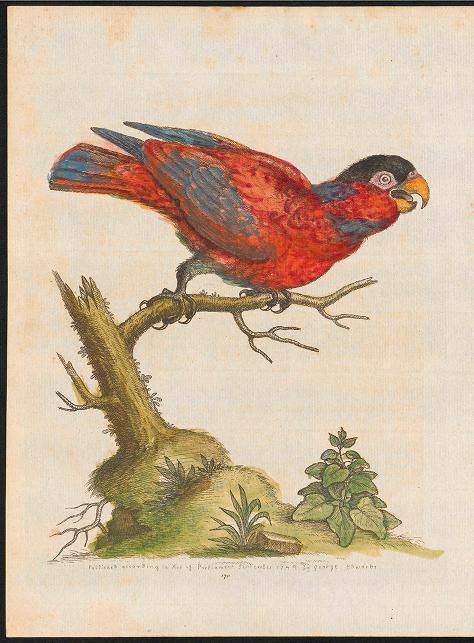
Black-capped lory diet
Wild diet
It’s important to know what a parrot eats in the wild, as it helps you figure out what this particular species should be fed in captivity. This is no different for lories like the black-capped lory; in fact, since their diet is so unusual, it’s even more important to make sure you’re aware of their dietary needs.
Lories’ strange, brush-tipped tongues reveal what these birds mainly eat in the wild: pollen and nectar. They’ll also consume entire flowers, as well as fruits and even insects.
The species’ digestive systems are completely adjusted to this mostly liquid diet and are notably short. Although they do have a crop, their gizzard is less muscular, as their food is easier to digest than something like seeds or other plant matter.
Lastly, lories’ poops are notoriously liquid. The manner of expulsion was described in one study I read as “forceful”! Basically, you’re interested in keeping one, be prepared for the spray poops.
Domestic diet
As you can probably imagine, a standard seed blend or parrot pellet food won’t cut it for a black-capped lorikeet. They need a specialized diet with plenty of high-quality nectar food to thrive.
Be sure to do your research and choose wisely: not all of the commercial lory and lorikeet foods found for sale are actually suitable. Research suggests that each species has different needs, and there’s still a lot we don’t know about optimum nutrition for these parrots.
Wombaroo is one of the most popular commercial brands right now and is generally considered high-quality.
According to research by avian vet Stacey Gelis, a suitable nectar mix would have a sugar content of 20-25% and contain some added protein (though not too much, as this will cause other issues). It’s also known that lories are sensitive to excess iron, so find a mix that has less than 100 ppm. The same goes for vitamin C.
The author mentions that when diluting the nectar, you should add around 30% water. More water makes the food more prone to quick spoilage, which is already something to look out for with these liquid diets.
You can supplement your black-capped lory’s diet with items such as:
- Fresh fruits (low in vitamin C and iron, like apples and pears)
- Dry lory/lorikeet food mixes
- Fresh vegetables and leafy greens (low in vitamin C and iron, like
- Small amounts of freeze-dried mealworms
Multiple sources of fresh water should also always be available.
Did you know? Because wet lory food spoils so quickly, you shouldn’t leave it in the cage for more than an hour or two. Clean the food bowl after each use to prevent illness.
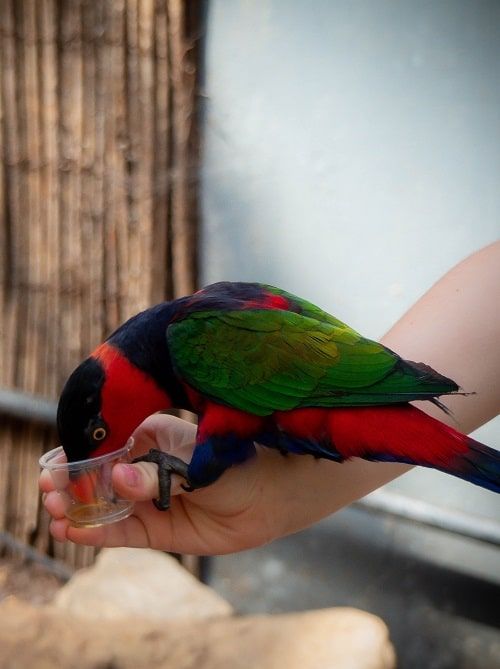
Black-capped lory housing
Cage
If you’re interested in keeping a black-capped lory, it’s important to keep in mind that these birds don’t do well in small cages. They’re active and need space to stretch their wings! A bird locked in a small enclosure, unable to move around much, will become stressed and obese.
If you’re planning on keeping your black-capped lory enclosed at all times, you’ll have to install an (indoor or outdoor) aviary. For birds that are out at least a few hours a day, a 40″ wide cage would do, although bigger is always better.
Given this species’ notorious splatterpoops, it’s probably a good idea to install some protection in and around the cage. Shower curtains can help keep walls clean, while washable table cloth or splat mats around the cage can protect the floor.
Be sure to stay diligent about cleaning the cage to prevent disease.
Cage décor
Because the black-capped lory is so active and curious, your parrot’s cage should end up looking a little like a birdie jungle gym. Provide plenty of natural perches, ladders and the like, though make sure there’s some open space left in the middle to fly.
Lots of toys, including foraging toys, are also important. Try rotating toys on a biweekly basis to keep things new and interesting!
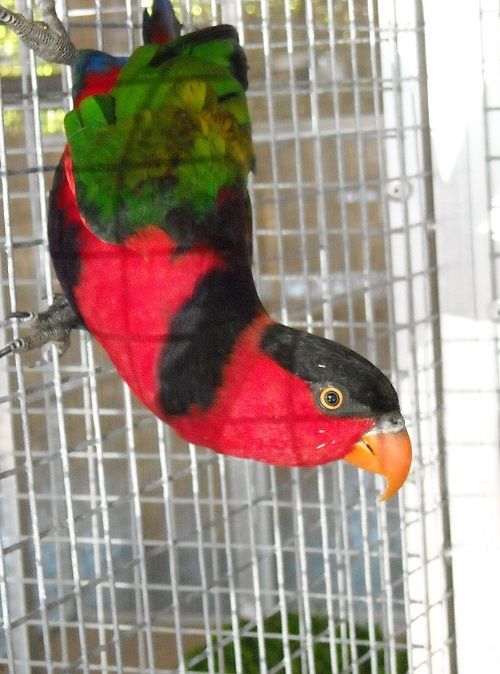
Black-capped lory enrichment
Social enrichment
Black-capped lories are extremely social. To prevent stress (and resulting issues like excessive vocalization, aggression or even feather plucking), yours should spend at least part of the day outside of its cage hanging out with you. If you don’t have time for this, like if you work a regular 9 to 5 job, you should get your bird a friend.
There are plenty of fun things that you can do with your black-capped lory while it’s out of its cage to help satisfy its social needs. Training time is especially ideal, as it allows you to teach the bird desirable behaviors while strengthening your bond at the same time.
You can even harness train parrots like these to be able to take them outside with you.
Other enrichment
As mentioned in the section on housing, giving your black-capped lory plenty of toys to play with in its cage is important. These guys are extremely active and curious, after all!
Having things to play with helps prevent stress caused by boredom and also reduces the chances of obesity, a big silent killer of pet parrots.
Foraging toys are an especially great way to keep your lory’s smart brain busy. Consider a foraging box, for example, or introducing different foods in new settings. Basically, just keep that bird moving and never let it sit still.
For time outside the cage, I always recommend setting up a natural playground. Parrots love it. It’s easy to move around so they can hang out with you, the toys keep them entertained and the natural wood is delightfully shreddable.
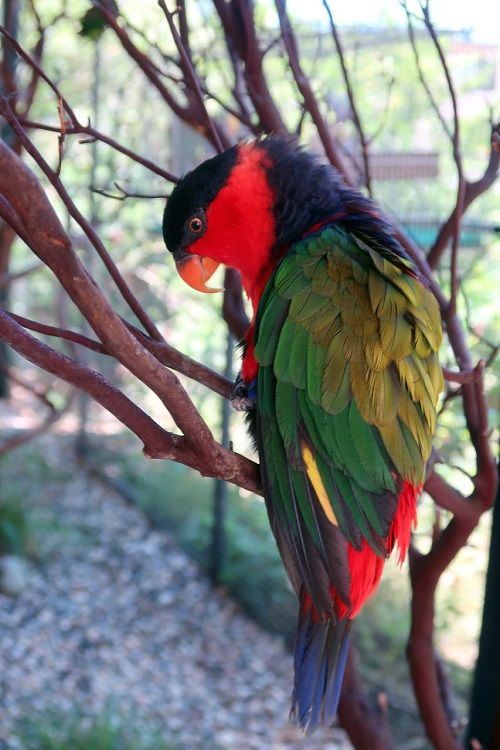
Black-capped lory temperament
Aside from their care requirements being so specific, one of the reasons lories aren’t for everyone is because they’re crazy. These parrots are hyperactive, whacky, intelligent, bouncy, playful and extremely curious.
Yes, they will destroy things in their endless search for the next way to cause mischief, and yes, you may get that freaky brush-tipped tongue stuck in your nose or ear several times a day.
If you like peace and quiet, parrots in general don’t make the best pets, but a black-capped lory would be especially exasperating to you. They need a lot of attention to keep their emotional needs met.
Although many love to hang out and receive neck scratches, keep in mind that an untrained lory can also be nippy. This can be countered through proper training.
Are black-capped lories noisy?
Well, they definitely aren’t quiet. No parrot is! I’d say that black-capped lories fall in the “medium” category in terms of noise. They’re loud, but one advantage is that their flock calls are relatively melodious; you can have a listen here. They do produce various high-pitched screeches and whistles as well.
Like most parrots, black-capped lories vocalize most around dawn and dusk, although screams, chattering and other noises can occur throughout the day. If you’re sensitive to noise, maybe a parrot is not the right pet for you.
Can black-capped lories talk?
Your black-capped lory absolutely has the potential to learn how to talk. These parrots are not bad at all at imitating whistles and other noises.
Although their voices are a bit hoarse, these parrots can also pick up short phrases.
Black-capped lory safety & emergencies
It’s definitely important for black-capped lory owners to consider safety, because these curious birds are very prone to getting themselves in trouble! You should have the number for an avian vet ready at all times.
Make sure any room that your lory has access to is fully bird-proofed: no open windows, no toxic houseplants, no cables to bite through, no ceiling fans running, no other pets (dogs/cats) present, no places where a parrot can get stuck, etcetera.
I highly recommend reading up on parrot emergency care and parrot safety.
If you have any more questions about black-capped lory care or if you’d like to share your own experiences with these colorful parrots, don’t hesitate to leave a comment below!
Sources & further reading
- Forshaw, J. M. (2010). Parrots of the World (Vol. 70). Princeton University Press.
- Gelis, S. (2011). A review of the nutrition of lories and lorikeets. In Proceedings of AVES International Parrot Convention.
- West, G. D., Garner, M. M., & Talcott, P. A. (2001). Hemochromatosis in several species of lories with high dietary iron. Journal of Avian Medicine and Surgery, 297-301.

